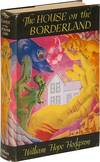
Steps to an Ecology of Mind.: Collected Essays in Anthropology, Psychiatry, Evolution, and Epistemology.
by BATESON, Gregory
- Used
- Hardcover
- first
- Condition
- See description
- Seller
-
London, United Kingdom
Payment Methods Accepted
About This Item
San Francisco: Chandler Publishing Company,, 1972. A cybernetic framework for environmentalism First edition, first printing, inscribed by the author on the front free endpaper, "For Lucy and Jack Saunders, from Gregory Bateson May 9, 1974". An influential text in environmental studies, this collection of essays sought "to disclose the patterns connecting different points of view in an ecological field" (ODNB). Gregory Bateson (1904-1980) was "a dazzlingly versatile thinker, whose work shaped the fields of anthropology, linguistics and cybernetics, as well as the movement we now call environmentalism" (Macfarlane). The son of the outspoken biologist and pioneer of genetics William Bateson, Gregory studied anthropology at Cambridge under the ethnologist A. C. Haddon. He spent his early years conducting fieldwork into the self-regulating systems that existed amongst the indigenous communities of New Britain and New Guinea. Following his wide-ranging research into cybernetics, schizophrenia, and inter-species communication, Bateson developed his influential "double-bind" theory, which he used to warn of an impending ecological and environmental crisis; he sounded one of the first warnings of the greenhouse effect and its potential to cause irreversible climate change in 1967. "He anticipated some innovative trends in late twentieth-century anthropology, such as exploration of the culturally viable relations between 'nature' and 'culture', of environmentalism, and the application of anthropology to the study of natural science" (ODNB). The work begins with a series of "metalogues" which take the form of conversations with the author's daughter, the cultural anthropologist Mary Catherine Bateson (1939-2021), on questions such as "Why Do Things Get In a Muddle" and "How Much Do You Know". The work discusses evolution, anthropological patterns, and the ecology of the mind. "By the late 1960s, Bateson had embraced the insights of second-wave cybernetics and developed a global, communication-based theory of being and evolution... [He] outlined a vision of the natural world as a set of information systems in interaction with one another. Individuals were both elements of this larger system and systems in their own right... Through cybernetics, Bateson explained, humans could finally recognise that the individual was no more than 'a servosystem coupled with its environment'" (Turner, p. 123). We have been unable to identify the recipients. Octavo. Original blue cloth, spine and rear cover lettered in white. With dust jacket. Frontispiece, 6 full-page illustrations. Head of spine gently bumped, faint foxing to top edge and endpapers, contents clean; jacket with pronounced insect damage in places, the spine and pictorial panels largely unaffected but resulting in some loss at extremities and splits along joints of flaps, the latter neatly repaired with Japanese tissue: a near-fine copy in a just about good jacket. Robert Macfarlane, "Why We Need Nature Writing", The New Statesman, 2 Sep. 2015; Fred Turner, From Counterculture to Cyberculture: Steward Brand, the Whole Earth Network, and the Rise of Digital Utopianism, 2006.
Reviews
(Log in or Create an Account first!)
Details
- Bookseller
- Peter Harrington
(GB)
- Bookseller's Inventory #
- 149421
- Title
- Steps to an Ecology of Mind.
- Author
- BATESON, Gregory
- Book Condition
- Used
- Binding
- Hardcover
- Place of Publication
- San Francisco: Chandler Publishing Company,
- Date Published
- 1972
Terms of Sale
Peter Harrington
All major credit cards are accepted. Both UK pounds and US dollars (exchange rate to be agreed) accepted. Books may be returned within 14 days of receipt for any reason, please notify first of returned goods.
About the Seller
Peter Harrington
Biblio member since 2006
London
About Peter Harrington
Since its establishment, Peter Harrington has specialised in sourcing, selling and buying the finest quality original first editions, signed, rare and antiquarian books, fine bindings and library sets. Peter Harrington first began selling rare books from the Chelsea Antiques Market on London's King's Road. For the past twenty years the business has been run by Pom Harrington, Peter's son.
Glossary
Some terminology that may be used in this description includes:
- Inscribed
- When a book is described as being inscribed, it indicates that a short note written by the author or a previous owner has been...
- Cloth
- "Cloth-bound" generally refers to a hardcover book with cloth covering the outside of the book covers. The cloth is stretched...
- New
- A new book is a book previously not circulated to a buyer. Although a new book is typically free of any faults or defects, "new"...
- Octavo
- Another of the terms referring to page or book size, octavo refers to a standard printer's sheet folded four times, producing...
- Flap(s)
- The portion of a book cover or cover jacket that folds into the book from front to back. The flap can contain biographical...
- Spine
- The outer portion of a book which covers the actual binding. The spine usually faces outward when a book is placed on a shelf....
- First Edition
- In book collecting, the first edition is the earliest published form of a book. A book may have more than one first edition in...
- Jacket
- Sometimes used as another term for dust jacket, a protective and often decorative wrapper, usually made of paper which wraps...







